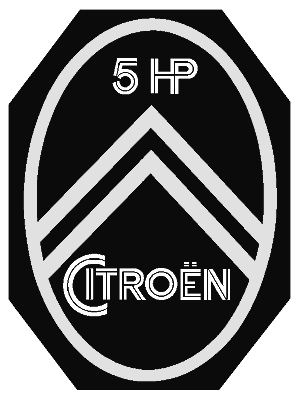Model T2 (Tourer)
Two-seater open tourer
Model designation: T2
Nickname: «Cul de Poule, hen’s bottom»
Description:
The body was of a wooden structure, on which the body panels were nailed.
The boattail gave a sporty appearance to the car.
The car has only one door located on the passenger side and opening to the front; reversed on the right-hand drive cars.
The door hinges were not visible. A tensioned conical bolt reduced vibrations of the door.
The spare wheel was mounted on the driver’s side (inside out) and fitted with a tyre upon delivery.
At the rear of the car was a boot, accessible from the top and closed by a lid. On both sides of the boot lid two supports serve to fit a suitcase of dimensions 40 x 80cm.
![Model T2 (Top view) [L28] Model T2 (Top view) [L28]](../../images/mod/5HP_T2_23_2gr.jpg)
| I | Lamps, bidirectional adjustable | VII | Luggage rack for case of 40x80cm size |
| II | Front and rear mudguards, black enamel | VIII | Luggage compartment (lid opens upwards) |
| III | Dashboard from Aluminium equipped with instruments | IX | Hood (protected by cover) |
| IV | Horn button for electrical horn | X | Side pocket |
| V | Comfortabe spring upholstered seat | XI | Aluminium floor panel |
| VI | Spare wheel | XII | Adjustable windshield |
The running boards were made of aluminium reinforced with long grooves. They were black in colour; the top of the grooves was polished. Wings and frame cover are made from black enamelled sheet metal. All four wings are reinforced by bordures. A body rail made of aluminium profile surrounds the upper edge of the body and is painted black.
The headlamps (bowls: black paint; rims: nickelled) were connected by an adjustable nickel-plated cross bar. Apart from normal road light there is also the possibility to switch on a parking light.
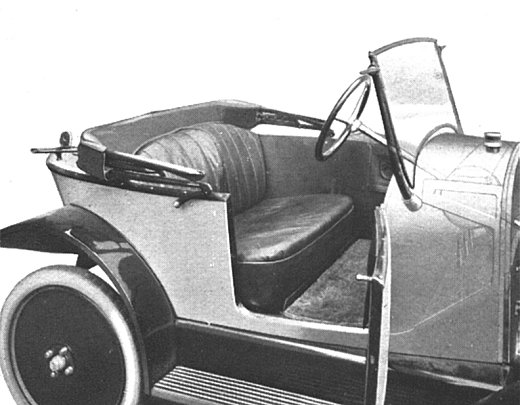
A very comfortable seat took two people. Door storage pockets were fitted in the door and alongside the driver. The floor covering was brush carpet. The polished and engine turned aluminium dashboard was simple, with only an ammeter and a headlight/ignition switch.
The pivot point of the movable windshield was placed in the top third section The convertible top was openable around a single axis and covered with waterproof fabric. The hood irons were bent ash. All weather equipment (side curtains) was provided; this included a cover to protect the folded hood from dust.
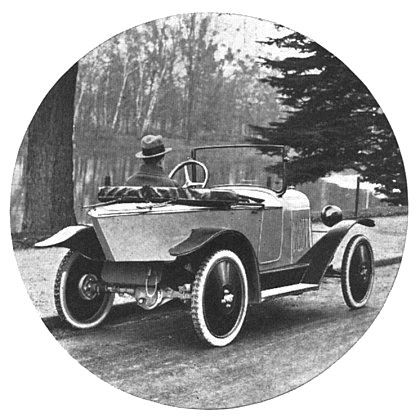
Model T2 on short chassis (T2/C2)
Production period from March 1922 until September 1922

The model T2 was based on the type C2 chassis with a wheelbase of 2.25m.
The aluminium running board measures 170 x 880 mm. The wooden frame construction is supported at the rear by two bent angled iron.
On early vehicles the bonnet had three louvres.
The ignition was by battery and coil, made by RB or Delco [L326].
Early models had a radiator with an integral soldered radiator grille, and with lower fixings riveted on.
This was replaced a short time later with a radiator with a removable nickel-plated radiator grille.
The windscreen brackets of the early version leaned towards the rear and protruded laterally from the body.
These were also replaced after a short time by the more easily mounted vertical versions.
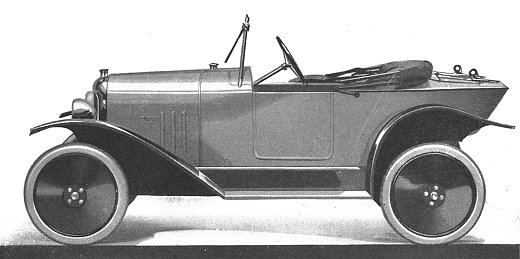
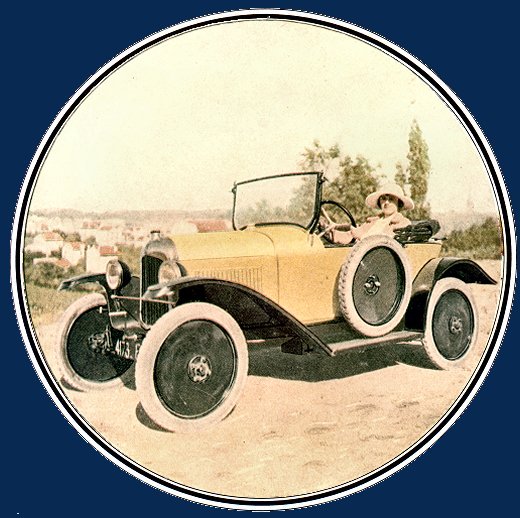
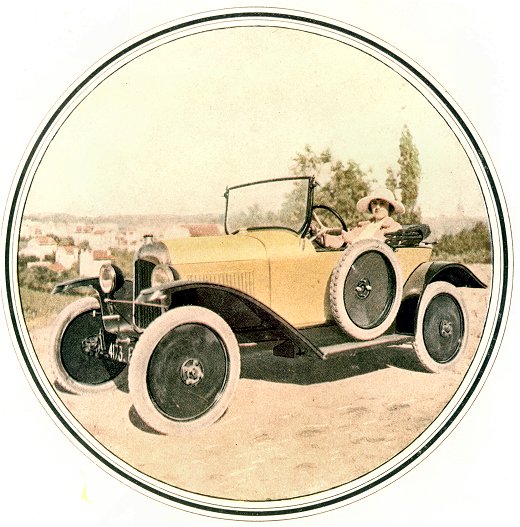
Colour scheme: Wheels, wings etc. were black. The bodywork and the bonnet were yellow (between a straw yellow and a pale "grapefruit" yellow). Radiator grille and lamp rims were nickel plated.
| Colour | Surface | Referred parts | |
| Black enamel | Wings, frame cover, rims, windshield frame, windshield columns, license plate, cover rail, luggage racks. | ||
| Yellow enamel | Bodywork, bonnet. | ||
| Black leatherette | Seats, side panels, pockets. | ||
| Nickel plated | Radiator grille, headlamp rims, lamps connecting rod, steering column, fuel tank cover, trim behind bonnet, bonnet locks. |
The 700x80 beaded edge Michelin "Cablé" tyres were inflated at "high pressure", (4 to 5 bars).
Production period from October 1922 until September 1923
The bonnet was provided with sixteen louvres on either side. The engine was supplied with a magneto ignition [L108]. The car was based on C2 chassis.
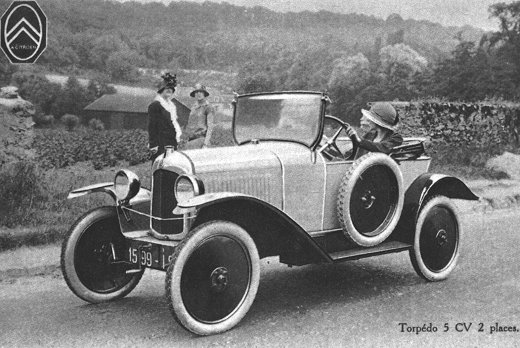
The yellow colour was dominant initially, then became supplemented by brown (havane) and red (maroon) in late summer 1923.
| Colour | Surface | Referred parts | |||
| Black enamel | Wings, frame cover, rims, windshield frame, windshield columns, license plate, cover rail, luggage racks. | ||||
| Yellow, brown (havane) and red (maroon) | Bodywork, bonnet. | ||||
| Black leatherette | Seats, seatrests, side panels, pockets. | ||||
| Nickel plated | Radiator grille, headlamp rims, lamps connecting rod, steering column, fuel tank cover, trim behind bonnet, bonnet locks. |
Model T2 on long chassis (T2/C3)
Production period from October 1923 until June 1925
In autumn 1923, the short chassis Type C2 was lengthened by 10cm from 2.25m (7 ft 5 in) to 2.35m (7 ft 9 in) and re-inforced by an additional crossbar which protruded from the rear deck and supported the rear of the body. This became the long wheelbase chassis Type C3. The C3 chassis now had a wheelbase of 2.35m. The rear reinforcements on the body were no longer necessary. The bodywork also increased by 10cm in length, noticeable by the increase in distance between the spare wheel and the wing. The running board measures now 170x980mm.
![Modell T2 [L8] Model T2 [L8]](../../images/mod/5HP_T2_24-1gr_520.jpg)
From June 1924 on all cars were equipped with low-pressure tyres "Michelin Confort" (balloon tyres) and the corresponding rims [L386]. The wheel dimensions are now 715x115 (balloon). For logistical reasons black was used as standard colour for the rims.
The cooling system was improved by the addition of a fan from June 1925 [L61]. The interior in black leatherette was also available in red and brown according to the body colour.
| Colour | Surface | Referred parts | |||
| Black enamel | Wings, frame cover, rims, windshield frame, windshield columns, license plate, cover rail, luggage racks. | ||||
| Burgundy red (maroon), blue or brown (havane) | Bodywork, bonnet. | ||||
| Red, black and brown leatherette | Seats, seat rests, side panels, pockets. | ||||
| Nickel plated | Radiator grille, headlamp rims, lamps connecting rod, steering column, fuel tank cover, trim behind bonnet, bonnet locks. |
Two-seater Torpedos on C3 chassis were manufactured until spring 1925.
Remark:
The asymmetric rims developed by MICHELIN (Bibendum, 12x45) were never originally fitted.
They became available in 1927 and in subsequent years, they have replaced the beaded rims of the vehicles still in use [L308].
MICHELIN's beaded edge tyres were offered in the MICHELIN catalogue until 1945 [L429, L430].
